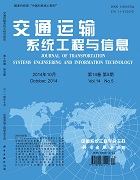To heighten the traffic safety level of urban arterial signalized intersection, signalized intersection upstream functional area space factor length formulas for the perception- reaction area , deceleration running area and queue area are proposed. On the basis of that, through analyzing traffic running regular pattern in signal intervals, which include red time, yellow loss, yellow initiation and green time, upstream functional area length models are established. Then the downstream functional area length model considering the decision sight distance is proposed, so that the signalized intersection minimum spacing formula based on the functional area length is determined. Finally, applying Technique for Order Preference by Similarity to Ideal Solution, adjacent signalized intersections of one arterial are taken as an example for calculation and evaluation. Evaluation results indicate that, compared with the present condition, the adjacent signalized intersection area which satisfies the minimum spacing has the higher traffic safety level. When the spacing is larger than the minimum value, the traffic safety level of the area tends to be stable. It can be seen that, through modeling the functional area length based on signal timing, the proposed minimum spacing calculation method could optimize signalized intersection spacing schemes and heighten the intersection location rationality.


